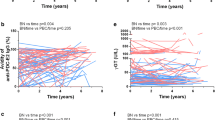Abstract
A 51-year-old woman who had been treated for primary biliary cirrhosis (PBC) was admitted to our hospital for evaluation of unexplained, isolated, persistently increased aspartate aminotransferase (AST) activity. Results of laboratory tests on admission showed: AST 171 KU, alanine aminotransferase 28 KU, and anti-mitochondrial titer 1/1280. Results of hepatitis B surface antigen (HBs Ag) and hepatitis C virus antibody (HCV Ab; C100-3) assays were negative. Histology of a liver biopsy specimen was compatible with a diagnosis of PBC (stage III of Scheuer's classificiation). The molecular size of serum AST was estimated to be more than 500 000 by high-performance size-exclusion liquid chromatography. Electrophoretic analysis showed an abnormal band of AST between supernatant AST (sAST) and mitochondrial AST (mAST), which band was characteristic of AST-immunoglobulin complexes (AST-Ig). Ouchterlony double-diffusion and immunoprecipitation tests identified the immunoglobulin component as IgM. The presence of AST-Ig appeared to be responsible for the elevated serum AST.
Similar content being viewed by others
References
Rosalki SB. Enzyme-binding immunoglobulins. Adv Clin Enzymol 1986;4:12–22.
Connelly MS, Kennedy HJ, Dawson CM, et al. Innocent elevation of aspartate aminotransferasc. Lancet 1989;I:847.
Scheuer P. Primary biliary cirrhosis. Proc R Soc Med 1967; 60:1257–1260.
Moriyama T, Ashiie T, Kikuiri K, et al. Mitochondrial aspartate aminotransferase linked to immunoglobulin G of the κ-λ type: Report of a case. Clin Chim Acta 1986;160:297–305.
Watazu Y, Okabe H, Sugiuchi H, et al. Proteolytic measurement of mitochondrial aspartate aminotransferase in human serum. Clin Biochem 23;127–130.
Tozawa T. Enzyme-linked immunoglobulins and their clinical significance. Electrophoresis 1989;10:640–644.
Wilding P, Cooke WT, Nicholson GI. Globulin-bound amylase: A cause of persistently elevated levels in serum. Ann Intern Med 1964;60:1053–1059.
Tozawa T. Electrophoretic analysis of enzyme-linked immunoglobulins and their clinical significance. J Chromatogr 1991; 569:347–365.
Konttinen A, Murros J, Ojala K, et al. A new cause of increased serum aspartate aminotransferase activity. Clin Chim Acta 1978;84:145–147.
Moriyama T, Nobuoka M, Makino M. Incidence and properties of aspartate aminotransferase-immunoglobulin complexes in patients with a high serum aspartate to alanine aminotransferase ratio. Clin Chim Acta 1990;190:47–56.
Williams ALB, Hoofnagle JH. Ratio of serum aspartate to alanine aminotransferase in chronic hepatitis. Gastroenterology 1988;95:734–739.
Sundin U. Antibody binding and inhibition of pyruvate dehydrogenase (PDH) in sera from patients with primary biliary cirrhosis. Clin Exp Immunol 1990;81:238–243.
Author information
Authors and Affiliations
Rights and permissions
About this article
Cite this article
Matsuda, Y., Amuro, Y., Hada, T. et al. Aspartate aminotransferase-linked immunoglobulin complexes in serum of a patient with primary biliary cirrhosis. J Gastroenterol 29, 218–222 (1994). https://doi.org/10.1007/BF02358687
Received:
Accepted:
Issue Date:
DOI: https://doi.org/10.1007/BF02358687




